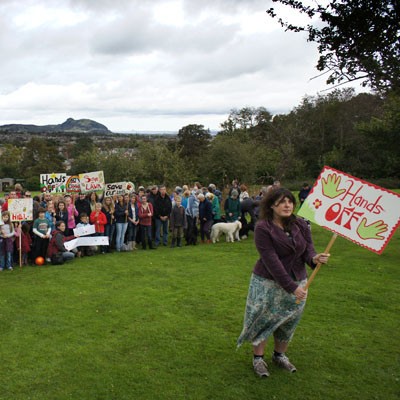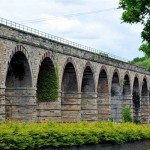One of Scotland’s most treasured beauty spots will soon be buried under concrete, the victim of a planning system which favours corporate greed over the needs of people and commons. By Rosy Barnes
Support independent, non-corporate media.
Donate here!

Craighouse is a stunning hilltop site on one of Edinburgh’s famous seven hills. A highly protected landscape with Grade-A listed buildings dramatically set against woodland, rolling parkland sweeps down to some of the most wonderful views in the city taking in the castle, Arthur’s Seat, North Berwick Law and the Lomond Hills. For generations, the local community and wider public have used this beauty spot for walking, bike-riding, watching fireworks, and climbing trees.
In March, the Craighouse Partnership’s application to put c.178,000 square feet of new-build development, plus roads and car-parks on this treasured area triggered one of the largest numbers of objection letters ever received by the city’s planning department for a single planning application. 1,200 people wrote in individual letters of objection. A petition was signed by over 5 and a half thousand local people wanting to preserve the green space and woodland from development.
Standing at Craighouse on a spring day – with the cherry trees in flower and the sweeps of daffodils nodding, the heart sinks at the thought of what is about to happen. The proposals are excessive and extremely ugly. Woodland will be ripped out for institutional-style modern blocks. Where the kids play football on grass under the flowering cherry and memorial trees, green space will disappear to become just one part of a large housing estate. Ugly newbuild will ruin the sensational views. New roads and hundreds of car-parking spaces are proposed for this peaceful, wildlife-filled nature conservation site. Approximately 70 trees (we estimate more) and countless shrubs will be ripped out on a site where all the trees have the equivalent of Tree Preservation Orders. Habitats of protected species are to be destroyed.
The Craighouse Partnership claims the listed buildings are unviable to develop without all this luxury new-build – yet for two years they have refused to release credible financial information to support this. The sheer number of companies involved – including Sundial Properties, Mountgrange, Napier University, agents, several architects and lobbyist Invicta PA should give an idea of what profits they expect to make. The site was protected when they bought it and they knew then they were not allowed all this new-build. So, why are we in this position?
Craighouse was built from 1888-94 by mental health pioneer Dr Thomas Clouston as a state of the art mental asylum – though the oldest building on the site, Old Craig, goes back to the sixteenth century. The landscape was fundamental to Clouston’s ideas of health and well-being. Seats were placed on the site to admire the panoramic views and the layout allows for an uninterrupted green sweep as part of that glorious vista. Clouston himself sited his great hospital here because he said it was “the most beautiful site in Edinburgh”.
The landscape has the same effect on the public today as it did then. We have letters from people who have used the site since the 60s – who, with their children, picnicked, played tennis and picked apples in the grounds. They want their grandchildren to be able to do the same. Craighouse was sold by the NHS to Napier University in the 1990s. Napier received a large amount of public money to convert the buildings to university use before deciding to offload the site less than 20 years later, selling it to an offshore company in the Isle of Man owned by the notorious Mountgrange (of Caltongate fame). Napier University are now part of the Craighouse Partnership seeking extra profit from the sale – receiving additional money according to how much newbuild they can get on the site.
The fact that Napier and Mountgrange are trying to hold out for such excessive amounts of newbuild on a site that is so highly protected by local and national policies as an Area of Great Landscape Value, Open Space in a Conservation Area, Local Nature Conservation Site, as the nationally important setting of Category A listed buildings and habitat of protected species – when it was made clear to them this was not reasonable – says much about what is going wrong with our planning system.
Edinburgh is potentially facing a green-space crisis. The council has announced a Proposed Local Development Plan that will see green belt significantly taken for new-build development. But they are also failing to protect our important green spaces in the city – the seven hills, Areas of Great Landscape Value, wildlife corridors and local parks. A major reason given for this is that the Scottish Government has demanded that more land be released for development. This, despite the fact that developers are already sitting on plentiful land-banked sites with planning permission to provide enough new housing stock for many years.
Land-banking is where developers gain planning permission for a site, thereby dramatically increasing its land value – and let it sit as an asset on their books or sell it on. They may sit on the site for many years or, indeed, have no plans to develop it themselves, merely taking money out of the site. Some developers boast of banks of thousands of consented sites on their balance sheets. Land-banking is a massive problem in Scotland – which neither the Council nor the Scottish Government are tackling. Once a site has increased its value, there is no need for a developer to build on it to see that value realised.
The estimates used for housing over the next 5 years are widely accepted to be far too high, and were based on excessive optimism of recovery in the housing market. So why are we sacrificing our important green sites when there are so many brownfield sites consented already that could be built on?
Developers seem to have managed to infiltrate government thinking to such an extent that we are not looking properly at what has real value in our lives. The idea of “economic growth” is talked of as though it’s synonymous with “whatever developers want”. It’s a win-win situation for developers – demanding they are given cheap-to-develop green field sites, whilst sitting on their stash of land-banked sites at the same time. But it’s lose-lose for the public. Not only do we lose important green space – vital for health and well-being, recreation and wildlife – but the derelict and brownfield sites we badly need developed lie abandoned. Areas needing regeneration are left to rot.
Economic growth is the mantra – but nobody looks closely at the real relationship between growth and development. Indeed, many larger Edinburgh developments in recent years have been disastrous financially. Rather than generate growth – they have made money for the few whilst wreaking havoc on the wider economy – losing millions in loans from banks we’ve had to bail out. Many of the projects presented by bodies like the Council or Historic Scotland as successes are financial disasters that lost tens, even hundreds, of millions of pounds for bailed-out banks. Other projects were pushed through against huge public opposition by planners and politicians for so-called economic reasons, but are now derelict holes in the ground.
The Craighouse Partnership is threatening that Craighouse’s Category-A listed buildings will go derelict if they don’t get their way – despite their responsibility to look after them. The truth is, there is nothing to stop them land-banking the site even if they get planning permission.
Granting more and more planning consents does not result in actual development or jobs. It results in money for the privileged few. The development industry, like banking, exists in its own bubble. We will never force developers to develop the consents they have if we let them ride roughshod over the rules and policies protecting our precious green spaces like Craighouse. Planning is in crisis and needs to get back to its proper role and function – planning and applying planning policy for the public good, not “enabling” development for development’s sake.
Is it all the planning department’s fault? Some say the pressure is coming from above. Indeed, of the few developments refused by council planning committees, it’s estimated 30-40% of them are overturned on appeal – a completely undemocratic, unaccountable process. Recent appeals by wealthy developers has seen a worrying number of planning committee decisions on
Edinburgh green sites completely overturned by government reporters, resulting in developers being granted large housing estates on an Area of Great Landscape Value and a Local Nature Conservation Site. To put this in context – other Areas of Great Landscape Value in Edinburgh are the Hermitage and Braid Hills, the Botanical Gardens and Arthurs’ Seat….
Not only is this profoundly undemocratic, but it makes a mockery of the system, showing no respect for the Local Development Plan or important designations and undermining planning itself.
There is no equivalent right of appeal for communities. I believe third party right of appeal for communities, or removing developers’ right of appeal, is fundamental to a fairer planning system. Planning is supposed to be about the public good, but an assumption that all development is good or development for development’s sake, has lost sight of both the public and economic good.
Planning decisions can hugely affect people’s lives. But developers have successfully lobbied to the extent that the public have no real idea what is going on in our system. It’s about time the public stood up and took their city back. We should not be held to ransom and forced to accept bad development. We want good development that creates attractive places out of brownfield sites and develops areas that need regeneration – not exploitation of Edinburgh’s wildlife sites, protected green spaces and fabulous hills. They are part of what makes Edinburgh so special.
The Craighouse Partnership wants to contravene rafts of planning policies and protections on a particularly stunning and special site – a gem in our city. If the planners and politicians don’t protect Craighouse, there is little hope for the rest of Edinburgh’s green or historic sites. At Craighouse, the public have stood up and said enough is enough. It remains to be seen whether the politicians and planners – and the Scottish Government itself – will listen.





